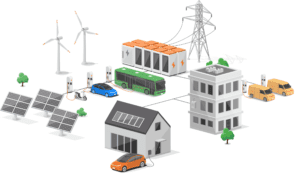
The challenge posed by surging demand for electricity from data centers and high-performance computing facilities presents an ideal time for innovative energy solutions that efficiently improve grid reliability and increase the availability of clean, affordable electricity.
Not only does the U.S. risk missing more than $100 billion of artificial intelligence (AI) market growth over the next five years if the grid can’t keep up, but the consequences of not keeping pace in AI—socially and economically—would likely dwarf the missed investment opportunities.
COMMENTARY
Much of this challenge hinges on the moments when the grid is pushed to its absolute limit, which together amounts to a small but critical window of mere hours or days within a year. If we can make demand flexible during these peak hours, we can unlock enough capacity to support growth industries like AI and enable greater productivity across our economy without waiting for new supply to come online.
Virtual power plants are at the forefront of flexible energy solutions due to their immediate availability and ability to scale. VPPs help balance the grid quickly and frequently by leveraging existing, on-site energy resources for a fraction of the cost and time needed to build generation.
The Grid Has the Capacity, We’re Just Not Using It
Despite efforts to the contrary, we cannot build our way out of our current challenge because it is not about a shortage of energy assets. Regulatory conversations and political efforts focus on putting steel in the ground, but the real opportunity is the nearly 100 GW of additional capacity on the grid waiting to be put to work.
By highlighting the scale of this opportunity, Duke University’s Rethinking Load Growth report reinforces what CPower and others in the demand response industry have long known— better managing large, customer-sited loads and distributed energy resources strengthens the grid and enables economic growth.
Therefore, rather than racing to build new supply, especially as AI pushes energy demand higher, we can use the energy assets we already have in smarter and more connected ways.
Why VPPs Are the Fastest Path Forward
VPPs use on-site energy assets like smart thermostats, batteries and curtailable loads to support the grid. Because each of these assets can quickly lower or shift their energy use when demand is high, they can provide the same flexibility and support as traditional power plants when combined into VPPs.
Participating in a VPP often involves making small adjustments to flexible loads like HVAC systems, lighting or industrial processes without disrupting operations. VPPs can also leverage power from backup generators, batteries and other energy sources located in businesses and homes.
VPPs already provide an estimated 30 GW to 60 GW of capacity in the U.S., but we could unlock another 80 to 160 GW of flexible capacity with them through greater adoption, according to the Department of Energy. Given that VPPs can be deployed in months without costly new construction, the resulting savings in time and money would be substantial,
For example, adding the same amount of new natural gas capacity could cost more than $100 billion (excluding fuel costs) and given supply chain constraints, grid and gas infrastructure build-out, interconnections could take more than a decade to complete. Similarly, nuclear energy is a 10-to-15-year solution to a five-year problem.
Policy Shifts That Can Unlock More Capacity
Some states already encourage large energy users to be part of the solution. In Texas, the recently enacted Senate Bill 6 requires new large loads, including data centers, to participate in load management programs, effective Sept. 1. Other regions, like PJM Interconnection and the Midcontinent Independent System Operator, Inc. (MISO), have started to expand VPP participation, but key barriers still must be addressed.
Although FERC Order 2222 was meant to make it easier for distributed resources to participate in wholesale markets, implementation in many areas has fallen short. Regulators can help by ensuring customer assets can enroll in multiple grid programs at the same time and giving local utilities the authority to coordinate VPPs directly. Improving access to non-sensitive smart meter data would also make it easier to bring more organizations into VPPs and enable faster payments for participation.
By focusing on these market and policy improvements, we can incentivize more large energy users to prioritize flexibility, thereby increasing available capacity on the grid and avoiding the building of expensive new power plants with long construction timelines.
The Path to a Smarter, Faster Grid
Perhaps most importantly, getting more from the grid we already have would allow AI and other rapidly growing, energy-intensive industries to access the energy they need faster, thereby producing the most widespread economic and societal benefits possible.
After all, AI and other energy-intensive industries don’t have to threaten the grid. They can be part of the solution by participating in VPPs.
A dispatched demand reduction through a VPP is functionally identical to a dispatch of increased generation from a peaker power plant. But VPPs provide the same benefit at a fraction of the time and cost, making them the fastest and most flexible way to meet rising demand while giving participating organizations new financial opportunities.
It’s time for us to stop thinking of demand flexibility as a backup plan and accept VPPs for their ability to immediately and efficiently improve grid reliability. They are the ideal innovative energy solution for the moment—and opportunities—before us.
—Mathew Sachs is the Chief Strategy Officer for CPower Energy.
